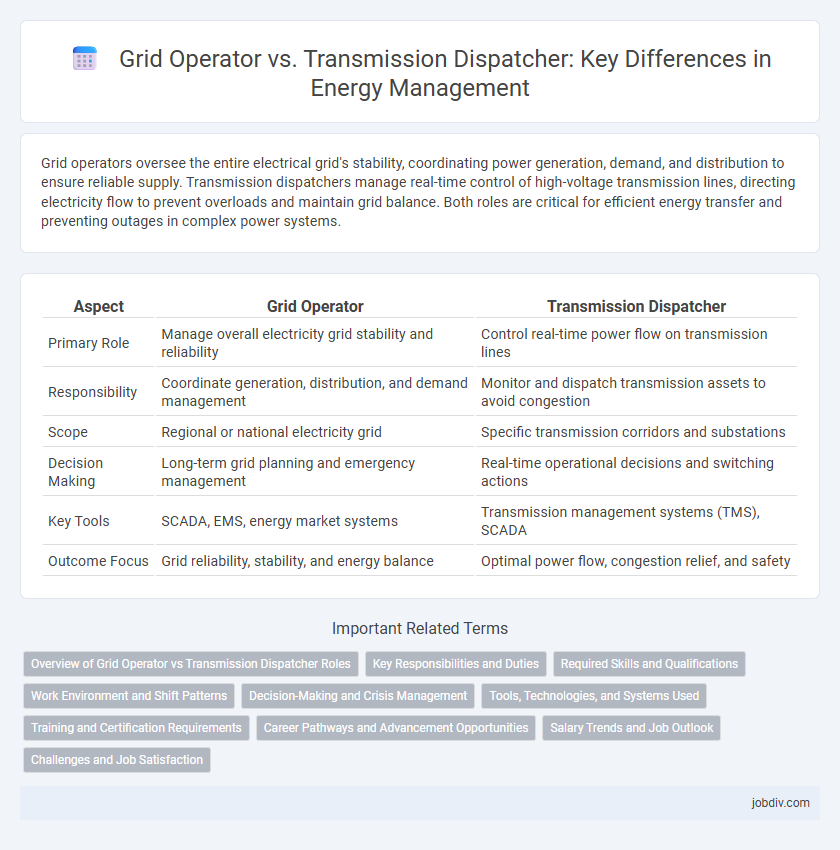Grid operators oversee the entire electrical grid's stability, coordinating power generation, demand, and distribution to ensure reliable supply. Transmission dispatchers manage real-time control of high-voltage transmission lines, directing electricity flow to prevent overloads and maintain grid balance. Both roles are critical for efficient energy transfer and preventing outages in complex power systems.
Table of Comparison
| Aspect | Grid Operator | Transmission Dispatcher |
|---|---|---|
| Primary Role | Manage overall electricity grid stability and reliability | Control real-time power flow on transmission lines |
| Responsibility | Coordinate generation, distribution, and demand management | Monitor and dispatch transmission assets to avoid congestion |
| Scope | Regional or national electricity grid | Specific transmission corridors and substations |
| Decision Making | Long-term grid planning and emergency management | Real-time operational decisions and switching actions |
| Key Tools | SCADA, EMS, energy market systems | Transmission management systems (TMS), SCADA |
| Outcome Focus | Grid reliability, stability, and energy balance | Optimal power flow, congestion relief, and safety |
Overview of Grid Operator vs Transmission Dispatcher Roles
Grid operators coordinate the overall electrical grid to ensure reliability and stability across regions, managing power flow and grid resources in real time. Transmission dispatchers focus specifically on controlling high-voltage transmission lines, directing energy transfer between substations to prevent overloads and minimize outages. Both roles are critical for maintaining balanced supply and demand, but grid operators handle broader system-wide oversight while transmission dispatchers manage specific transmission infrastructure operations.
Key Responsibilities and Duties
Grid Operators manage the overall stability and reliability of the electrical grid by coordinating energy flow and balancing supply with demand in real time. Transmission Dispatchers focus specifically on controlling and monitoring the high-voltage transmission network, ensuring safe and efficient power transmission from generators to distribution systems. Both roles are critical for preventing outages, managing grid congestion, and maintaining compliance with regulatory standards in energy markets.
Required Skills and Qualifications
Grid Operators require strong analytical skills, proficiency in energy management systems, and knowledge of power grid operations to ensure reliable electricity distribution. Transmission Dispatchers must have expertise in real-time grid monitoring, rapid decision-making abilities, and a deep understanding of electrical transmission regulations and safety protocols. Both roles demand a background in electrical engineering or energy management, combined with certifications such as NERC System Operator or equivalent industry qualifications.
Work Environment and Shift Patterns
Grid operators typically work in centralized control centers managing overall grid stability with shift patterns that cover 24/7 operations, often including rotating and night shifts to ensure continuous monitoring. Transmission dispatchers focus on real-time control of power flows and system contingencies, frequently working highly structured shifts within control rooms equipped with advanced grid management technologies. Both roles require high concentration and the ability to respond swiftly to grid disturbances, often under high-pressure conditions.
Decision-Making and Crisis Management
Grid operators manage the overall coordination of electricity flow across the network, ensuring grid stability and reliability through strategic decision-making. Transmission dispatchers focus on real-time control and operational adjustments, responding swiftly to unexpected disruptions or crises to maintain continuous power delivery. Both roles require precise communication and rapid problem-solving to mitigate risks and restore balance during emergencies.
Tools, Technologies, and Systems Used
Grid operators utilize advanced Supervisory Control and Data Acquisition (SCADA) systems and Energy Management Systems (EMS) for real-time monitoring and control of the electric grid. Transmission dispatchers rely on specialized Geographic Information Systems (GIS) and Outage Management Systems (OMS) to manage transmission line operations and coordinate rapid response to faults. Both roles integrate Phasor Measurement Units (PMUs) and Wide Area Monitoring Systems (WAMS) to enhance grid reliability and situational awareness.
Training and Certification Requirements
Grid Operators must complete comprehensive training programs certified by regulatory bodies such as NERC to ensure compliance with North American Electric Reliability Corporation standards. Transmission Dispatchers require specialized certification focusing on real-time system operations and emergency response, often obtained through extensive hands-on simulation exercises. Both roles demand ongoing professional development to maintain up-to-date knowledge of grid management technologies and regulatory changes.
Career Pathways and Advancement Opportunities
Grid Operators oversee the overall management and reliability of the electrical grid, requiring strong skills in system monitoring, coordination, and emergency response. Transmission Dispatchers focus on controlling the flow of electricity across transmission lines, demanding expertise in real-time decision-making and load balancing. Career advancement for Grid Operators often leads to senior management or control center supervisor roles, while Transmission Dispatchers may transition into specialized technical roles or transmission system planning positions.
Salary Trends and Job Outlook
Grid Operators typically earn between $60,000 and $90,000 annually, with median salaries around $75,000, while Transmission Dispatchers often report higher wages ranging from $65,000 to $95,000 due to specialized technical responsibilities. Both roles are experiencing steady job growth, projected at approximately 5% over the next decade, driven by increasing demand for reliable energy distribution and grid modernization initiatives. Salary trends reflect the critical nature of these positions, with opportunities for advancement linked to experience and certifications in energy management systems.
Challenges and Job Satisfaction
Grid Operators manage the overall balance and stability of the electrical grid, facing challenges such as real-time load forecasting inaccuracies and integrating renewable energy sources. Transmission Dispatchers focus on controlling high-voltage power flow and responding to outages, with stress stemming from emergency response demands and maintaining system reliability. Job satisfaction for both roles is influenced by the critical nature of their work, teamwork dynamics, and technological advancements enhancing operational efficiency.
Grid Operator vs Transmission Dispatcher Infographic

 jobdiv.com
jobdiv.com